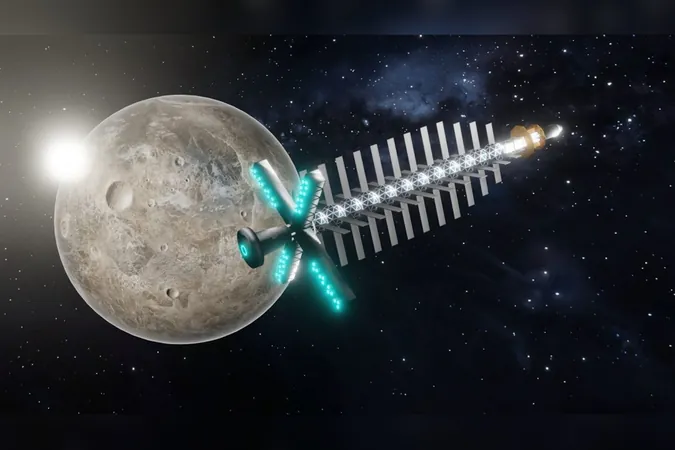
Revolutionizing Space Travel: The Advent of Nuclear-Powered Spacecraft by the 2030s!
2024-11-19
Author: Ming
Introduction
In a groundbreaking move for the future of space exploration, a coalition of companies has recently wrapped up the initial phase of an ambitious 11-year project, setting the stage for the world's first nuclear-powered space tug. Dubbed RocketRoll, this initiative outlines a comprehensive roadmap aimed at creating advanced propulsion systems that will usher in a new era of long-duration space missions, essentially providing space agencies with a viable nuclear alternative to traditional propulsion methods.
Project Overview
RocketRoll's successful completion means the consortium can pivot towards the design and eventual launch of a technology demonstrator, a pivotal mission that will provide unprecedented insights into the potential of nuclear power in space travel. If all goes according to plan, the demonstrator could fundamentally alter the way we think about powering spacecraft, making nuclear energy the predominant option for future missions.
Challenges and Advantages
The challenges of fuel logistics in space are significant. Conventional propulsion systems, while effective, do consume valuable cargo space to house their fuel. Once that fuel is exhausted, spacecraft are left adrift, vulnerable to the inherent limitations of physics. NASA has articulated the critical advantage of nuclear propulsion, stating it can deliver efficiency that surpasses the most advanced chemical systems and is less reliant on solar energy — a crucial factor for deep space explorations where sunlight is scarce.
The Need for Robust Propulsion Systems
"As we delve deeper into the mysteries of our solar system, the need for robust and efficient propulsion systems becomes paramount," noted the European Space Agency's Commercialization Gateway. “Nuclear Electric Propulsion (NEP) has the potential to revolutionize our capacity for exploration, making missions to the Moon, Mars, and beyond more feasible than ever.”
Goals of the RocketRoll Initiative
The RocketRoll initiative—formally known as the Preliminary European Reckon on Nuclear Electric Propulsion—aims to lay the groundwork for a demonstrator by 2035. This spacecraft will validate the design of the technology and identify critical gaps in systems that need addressing before embarking on larger missions.
Applications of Nuclear Electric Propulsion
Furthermore, RocketRoll seeks to highlight the benefits of utilizing a Nuclear Electric Propulsion tug, particularly for challenging missions in future space logistics and exploration. Potential applications include powering habitats or robotic explorations on the lunar and Martian surfaces, as well as performing other critical tasks in space beyond mere propulsion.
Nuclear Power Generation in Space
One of the fascinating aspects of this project is its approach to generating nuclear power aboard a spacecraft. According to Tractebel, the strategy focuses on a broad spectrum of nuclear solutions, ranging from radioisotope systems to more complex fission projects. The specifics of how nuclear energy will be harnessed remain to be established, but fission seems to be the front-runner among the technologies currently in development.
Understanding Nuclear Fission
Nuclear fission, the process central to today's nuclear reactors, is distinct from its more well-known counterpart, nuclear fusion. While fusion powers our Sun and offers superior energy yield and lower waste, achieving commercial viability for fusion remains elusive. Despite the controversies surrounding nuclear energy, it has consistently provided around 20% of America's electricity since 1990, underscoring its potential as a resource.
Investments in Nuclear Technologies
In 2023 alone, the Pentagon invested in nuclear propulsion advancements, awarding Lockheed Martin a substantial $33.7 million contract through the Joint Emergent Technology Supplying On-Orbit Nuclear (JETSON) program. Concurrently, NASA and DARPA joined forces with the aerospace giant to pursue DRACO (Demonstration Rocket for Agile Cislunar Operations), a project set to utilize fission-produced nuclear energy. Rolls Royce also announced significant advancements in developing a nuclear engine prototype earlier this year.
Emerging Concepts and Future Prospects
Further demonstrating a shift towards nuclear technologies, NASA's Innovative Advanced Concepts (NIAC) program identified a pulsed plasma rocket fueled by fission as one of its promising mission concepts—adding yet another intriguing layer to the evolving landscape of space technology.
Conclusion
The RocketRoll project promises to be a game-changer, paving the way for a future where nuclear power may not only support human exploration of the cosmos but redefine our capabilities in space missions. Stay tuned, as we watch this revolutionary technology unfold—the future of space travel is more exciting than ever!



 Brasil (PT)
Brasil (PT)
 Canada (EN)
Canada (EN)
 Chile (ES)
Chile (ES)
 España (ES)
España (ES)
 France (FR)
France (FR)
 Hong Kong (EN)
Hong Kong (EN)
 Italia (IT)
Italia (IT)
 日本 (JA)
日本 (JA)
 Magyarország (HU)
Magyarország (HU)
 Norge (NO)
Norge (NO)
 Polska (PL)
Polska (PL)
 Schweiz (DE)
Schweiz (DE)
 Singapore (EN)
Singapore (EN)
 Sverige (SV)
Sverige (SV)
 Suomi (FI)
Suomi (FI)
 Türkiye (TR)
Türkiye (TR)